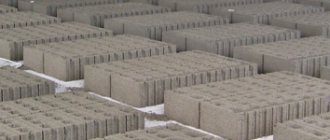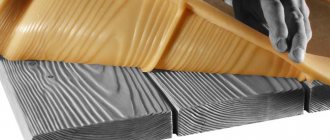The concept of liquid stone combines several types of modern finishing materials that are produced using similar technology. Outwardly, it resembles natural stone.
Brief analysis of the business: Costs of organizing a business: 250,000 - 350,000 rubles Relevant for cities with a population: from 300 thousand Situation in the industry: the scope of proposals is free Difficulty of organizing a business: 3/5 Payback period: 4-7 months
Liquid stone usually refers not to the resulting material, but to the technology that makes it possible to cover any surface. Often this method is used to cover chipboard, plywood or MDF. Liquid stone is obtained by mixing general purpose resin with other components. The thickness of the facing layer of the product can be from 3-4 mm to several centimeters.
Description
Externally, artificial stone is very similar to natural stone. However, it feels different to the touch, as it is warmer in comparison with the specified material. This is an important feature of it. Items made from liquid stone have high quality and durability, as well as a number of advantages over products made from natural materials.
For example, artificial marble is more durable than natural marble. Also, it will not crack from exposure to negative external factors. And artificial granite will not be radioactive, which cannot be said about natural granite, which often has this, perhaps, the most serious drawback.
Advantages of cooperation with our company
We are a manufacturer of decorative fillers for SkillStone liquid stone, therefore we offer competitive prices. Extensive experience in the production of granules for artificial stone, highly professional staff and knowledge of all the intricacies of production technology allow us to create products of the highest quality.
SkillStone artificial stone fillers are certified and comply with international standards
The company's warehouse always has decorative fillers for SkillStone liquid stone in any volume.
Liquid stone production technology
This process is virtually waste-free and very simple. People can do this interesting activity even without special training. So, the production of liquid stone can be carried out without much difficulty. The resulting coating can be applied to any surface: iron, ceramics, wood, glass and even plastic.
The entire technology of liquid stone consists of four stages, using appropriate equipment in each of them.
- First, prepare the working surfaces for applying materials. They improve the bonding of the liquid mass to the base.
- Next, you should prepare a container into which water is poured, and then the desired mixture is poured.
- After this, everything is mixed using a special nozzle.
- When the liquid is brought to a state of plasticity, it can be applied to the desired product, and when the material hardens, all that remains is to polish it to a mirror shine.
The equipment used is a sprayer, which ensures uniform distribution of the specified material, and a pneumatically driven grinding tool with a round structure. These devices are important. With their help, the surface is polished and cleaned, and only then brought to a shine.
It seems that liquid stone technology is not complicated. But it is possible that you may need the help of a process engineer.
Unique decorative coating - liquid stone
Liquid stone “Coverstone” is a unique decorative and finishing material for facades and interiors, which consists of 96% natural stone. Liquid stone "Coverstone" can be applied to any type of surface: plastered walls, concrete slabs, metal, plastic and various types of decorative panels, except for surfaces that actively absorb moisture. Coverstone coating is resistant to any, even the most extreme weather conditions, has high moisture resistance, fire resistance, and vapor permeability, is not afraid of vibrations and slight deformations, which ensures a guaranteed service life of more than 25 years. The range includes natural stone textures: travertine, granite, marble in various colors. The material is supplied in dry form, after dilution the consumption is 1.5-2 kg. per sq.m.
Travertine texture
Granite texture s01
Granite texture s02
Marble texture
Brick texture
Application of liquid stone:
To apply the coating you will need the following tools and consumables: spatula, trowel, paint roller, air gun, compressor for applying decorative coatings, special Coverstone tape, PR-18 primer and P-08 stabilizing impregnation.
Before applying the material, you should carefully check the surface for evenness and absence of defects. To obtain an optimal result, the surface must be cleaned of fragments of building mixtures. After cleaning, the surface should be primed and left to dry for 24 hours. During the drying period, the surface should not be exposed to moisture. If the coating is applied to the facade, you should first familiarize yourself with the weather forecast for the next day or protect the facade from precipitation.
After 24 hours, apply a second coat of primer.
Next, the first layer of the base coat is applied. Add 4-6 liters of water to the bucket with the dry mixture and mix with a mixer at medium speed. The first layer is applied as evenly as possible. After application, the surface is left to dry for at least 4 hours at a temperature of at least 5 degrees and average humidity. If you plan to make an imitation of masonry with a seam, then the first layer of coating can be tinted with the required shade. After the surface has dried, to simulate jointing, make a mark of the desired size and mount special tape on it.
The second layer is applied using a pneumatic gun. We are preparing a new mixture. Spraying is done in small areas in order to have time to smooth out the applied coating before it has time to dry.
Remove the previously glued tape before the material dries. For the coating to dry completely, it takes at least two days at a temperature of at least 5 degrees and average humidity.
If you want to get the effect of polished stone, then after the surface has dried, you need to grind it with light movements at medium speeds with an abrasive number from 120 to 150 and a diameter of 180 mm. If you want the surface to be more textured, apply an additional layer of coating.
Next, apply a layer of special finishing impregnation with a roller. The surface is ready.
Liquid stone catalog:
Products made from artificial liquid stone
From this material you can make:
- monolithic countertops of different sizes;
- bar counters;
- sinks;
- counters;
- countertops with built-in sinks for bathrooms;
- window sills;
- decorative items, furniture and interior items.
Thanks to its unique qualities, liquid stone, the production technology of which is not difficult, allows you to create any necessary elements of the most varied shapes and sizes, as well as any complexity.
A wide range of applications will always ensure great demand for products made from this material. At home and in the office, in shops and public transport, at food enterprises and in crowded places, products made from this artificial stone are found. Interior details made from this material are also pleasing to the eye. They make the space around cozy and prestigious.
There are the following stages of manufacturing stone products:
- spraying,
- grinding.
They are carried out in different rooms with the obligatory presence of a hood and heated to a temperature of 20-23 oC. Chemicals evaporate during the manufacturing process, as a result of which this product will not cause harm to human health. The grinding room must be equipped with an outlet with a compressor connector.
Manufacturing methods
The “artificial stone” technology has two methods for manufacturing products - direct and reverse.
The direct method is that the filler is applied to a pre-prepared piece of chipboard or plywood. Immediately after the filler has hardened, the surface of the product is ground and polished. The disadvantages of this method are the high consumption of materials and the manufacturing time.
We practice the reverse method. In this case, less effort is applied to processing (grinding) the finished product.
Reverse method. The production of liquid stone using the reverse method is carried out as follows: two blanks are cut out of an MDF sheet, which are exact copies of the tabletop. The parts are glued together, and if necessary, cutouts are made for the sink or hob.
View the embedded image gallery online at: https://skillstone.ru/tekhnologiya-proizvodstva.html#sigProId4ea6856729
The finished part is transferred to the work table. On the work table, the parts are covered around the perimeter and in the cutout area under the hob with pre-prepared strips of chipboard, plywood or plastic. The strips are placed on the edge and fixed with hot glue. Next, mark the location of the sink with a pencil on the desktop.
After this, the workpiece is removed from the resulting formwork (mold). Subsequently, the workpiece is cut 5 mm on each side and milled in the areas of the future edge.
Using the marks made with a pencil, the shell matrix is established. The gap between the matrix and the work table is covered with plasticine.
View the embedded image gallery online at: https://skillstone.ru/tekhnologiya-proizvodstva.html#sigProId9f01cbf867
Plasticine is laid out along the end where there will be a decorative edge. Using a template that follows the contours of the cutter, the plasticine is given the required shape. Then the entire surface of the formwork and matrix (shell) is treated with a release agent - wax. After 15-20 minutes the mold is ready for filling.
View the embedded image gallery online at: https://skillstone.ru/tekhnologiya-proizvodstva.html#sigProId18fa95a9c7
SkillStone filler and gelcoat is prepared according to the following proportions: SkillStone - 40%, gelcoat - 60%. After introducing the hardener (1-1.5%), the finished mixture is evenly sprayed onto the mold. Consumption is approximately 4 kg. per 1 sq.m. The applied material should harden (polymerize) within 30-45 minutes.
View the embedded image gallery online at: https://skillstone.ru/tekhnologiya-proizvodstva.html#sigProId96c9a7284e
The hardened form is reinforced with fiberglass. After this, the pre-prepared soil (resin with the addition of calcite) is poured out and evenly distributed over the entire area of the workpiece. The primer is painted with pigment pastes in the color of the SkillStone .
View the embedded image gallery online at: https://skillstone.ru/tekhnologiya-proizvodstva.html#sigProIdbd41ef7f30
A previously prepared piece of MDF or chipboard is placed into the mold filled with soil. Loads are distributed from above over the entire surface plane of the product to remove excess soil and air. After 1-1.5 hours, the weights are removed, and the surface is cleaned and refilled with soil.
View the embedded image gallery online at: https://skillstone.ru/tekhnologiya-proizvodstva.html#sigProIdc12f3e7fb1
After complete polymerization, the finished product is removed from the work table and processed: grinded, milled, polished.
View the embedded image gallery online at: https://skillstone.ru/tekhnologiya-proizvodstva.html#sigProId46a63cb0fa
Liquid stone has a fairly wide range of colors: today there are about two hundred standard colors. But if you don’t find the right color among this variety, artificial stone production technology allows you to create a shade to suit every taste.
The technology for producing liquid stone has some subtleties and nuances. We are always ready to provide maximum information on all issues of interest, which will help you make artificial stone with your own hands .
Caring for artificial stone products
The surfaces of any elements made of this material can be cleaned quite easily using the most common detergents, even if the nature of the contamination is very strong. No special skills are required here.
Tabletops are washed with a regular cloth moistened with warm water. Any cleaning agents can be used, since the stone is very durable and is not afraid of anything, even without an additional protective coating. The only exception would be abrasive detergents if the surface is polished.
Products made from liquid stone can also be easily repaired. If chips and scratches appear during long-term use, you can even get rid of them yourself using ordinary sandpaper and polish. But larger and more serious damage will be repaired by professionals who will simply spray liquid stone on top and polish the resulting surface with high quality. However, you can also complete this process yourself.
LiveInternetLiveInternet
Quote from Galina_Bikmullina's message
Read in full In your quotation book or community!
Currently, products made from liquid stone are extremely popular. The material, which has unique properties, is used to make kitchen countertops, window sills, sinks and many other products.
Liquid stone products are in stable demand on the market. This probably primarily explains the high price of the products. Although the cost of the same countertop made of liquid stone is several times less than its retail price.
If you follow all the rules and regulations, setting up the production of the same countertops at home is not such a difficult task. I think this is a good idea for developing your own business.
The technology for making products from acrylic resin is in many ways similar to that invented by home cooks back in the 70s and 80s of the last century. True, for this they used the most accessible material at that time - epoxy resin.
Having available white sand, chalk, diabase black flour, and white marble chips as a filler, products were obtained that resembled marble in appearance. By adding various non-aqueous dyes, we sometimes obtained a very beautiful surface. The consumption of dyes was selected experimentally.
The mixture consisted of 80% filler, 18% binders and 2% dye. To prepare the mixture, a diluent was added to the resin and mixed thoroughly, then a hardener was added and mixed again. After this, the mixture was heated in a “water bath” to approximately 50 degrees, filler was added, mixed thoroughly, then dye was added and mixed again. Next, the mixture was poured into the mold.
The form was prepared as follows. They took a sheet of glass and carefully wiped it with a cloth moistened with acetone, and then with a dry cloth. Wax mastic was applied and after 20 minutes polished with a dry cloth. The surface quality of the resulting product subsequently depended on how thoroughly the glass was pre-treated.
For the sides, polished aluminum corners were used, on the inner surfaces of which a thin layer of a mixture of paraffin and turpentine was applied. The mixture was pre-prepared in a “water bath” by melting paraffin in turpentine, and then cooled to room temperature. The sides were attached to the glass using putty.
If plexiglass was used instead of glass, then the mixture did not stick to it, and in this case they did without mastic.
To obtain a surface similar to marble, a basic mixture and, in smaller quantities, an additional mixture of a different color were prepared. The form was placed strictly horizontally. Added a little extra mixture to the main mixture. We made several circular movements with a stick on the surface of the mixture and the top layer was transferred to the mold. This was repeated until the form was completely filled out.
In order for air bubbles to escape, the first layer was applied with a thickness of no more than 10 mm, and subsequent portions of the mixture were transferred after 30 minutes.
If the product was at room temperature, then after 15-18 hours the sides were removed and the product was separated from the glass. The bays were cut off with a knife, and the cut area was carefully polished.
It is undesirable to use products made of epoxy resin in enclosed spaces, but on terraces and utility rooms you can make floors and stair steps. In this case, crushed pebbles 2-4 mm in size are added to the epoxy resin as a filler. Using pebbles of various colors, you can get a beautiful floor covering.
Using acrylic resin as a binding element, for example, Technakryl, produced in Cheboksary, I am thinking of making a tabletop using this technology. If anyone already has a similar experience, please share it with the people. Your experience will be featured in the blog.
TOOK IT HERE: https://iddeas.ru/novosti/zhidkij-kamen.html
The main advantages of artificial stone
This material has the following advantages:
- possibility of repair in case of damage to the product;
- large selection and abundance of decors;
- wide range of colors;
- unique seamless joining technology;
- the ability to produce countertops with built-in sinks;
- high resistance to aggressive environments, high humidity, mold and mildew;
- hygiene, environmental friendliness and absolute safety;
- durability;
- ease of use;
- ease of product care.
Artificial stone countertops do not stain stains from wine, jam, tea and coffee. But this is very important for kitchen furniture. Products made from this material do not deteriorate under the influence of kerosene, gasoline, acetone, hydrogen peroxide and ammonia, as well as hydrochloric and sulfuric acid. All these numerous advantages make it simply irreplaceable material.
Description of the technology and history of its creation
Liquid stones for nail design are an imitation of precious stones in a three-dimensional design using polymer materials.
There is a special composition called “Liquid Stones”. It is transparent in color and polymerizes in a lamp. If you mix it with gel paint or stained glass gel varnish, you can achieve the effect of rubies, emeralds, opals, and sapphires.
Manicure design technology was developed by master Ekaterina Miroshnichenko more than 5 years ago, and every year it is gaining more and more popularity. She combined a number of techniques, including gel extensions, sculpting, and metal casting, to achieve voluminous shapes. Rich color was achieved thanks to gel and stained glass paints and varnishes. The result is a realistic imitation of precious stones that is practical to wear, has a dense texture and is adapted to the size and shape of the nail plate.
The first designs were performed on long extended nails, allowing the creation of voluminous, multi-component compositions. The imitation looks just as beautiful on short nails, you just need to adapt the size and proportions of the design.
How to design liquid stones on nails if you do not use the polymer of the same name? Modern masters have come up with a number of other techniques using materials for design and nail extensions, which allow them to create the same voluminous, convex shapes and cameos. You can use topcoat, gel paint, extension gel, acrylic, crystals and broths to create a wide variety of raised designs and their frames on your nails.
How to choose the right gel polish: we analyze all its types and top brands
Own business - production of liquid stone
With the right approach, organizing this plan is not so difficult. Having your own business producing artificial stone is a very good idea. The production of liquid stone can bring considerable income, and also become a truly favorite activity.
The production of this material began relatively long ago. Previously, natural stone was used in the decoration of walls and facades of buildings and structures, but now artificial stone is used more and more often. This material calmly and unobtrusively fills the modern construction market. Yes exactly. Is it possible to impose quality? The consumer himself chooses the best.
And even if the customer cannot choose the right option among all the variety of colors, you can always make the product according to your individual wishes.
Artificial stone is very light, which means that its transportation will not require large expenses. It is resistant to temperature changes and environmental influences, as a result of which it will be easy and safe to store in a warehouse without fear of damage.
Where is it used?
Liquid stone is a mixture of chemical components that reacts upon contact with water or a solution of gelcoat and filler. As a result, a liquid, plastic substance is formed, which, when hardened, gives a structure that looks like natural stone.
A thin layer of artificial stone creates the effect of a laminating coating. A chemical reaction occurs, as a result of which the liquid components of the mixture polymerize, transforming into a thin layer, similar in structure to natural stone - granite or marble. Most often, liquid stone is used:
- in the production of sanitary products, in particular sinks;
- in the cladding of walls and facades;
- in the manufacture of floor coverings;
- in the manufacture of steps for stairs;
- when finishing swimming pools;
- in the manufacture of various products used in the interior, such as window sills and tabletops.
Liquid stone is used to create interior design, as it perfectly decorates the most complex surfaces, replete with irregularities and corners. With its help you can create the perfect coating on any surface.
We recommend that you read similar articles:
- Production of paving stones
- Arbolite blocks
- Production of colored crushed stone
How to implement a business idea for the production of the specified material
To do this, the following criteria must be taken into account:
- The production of liquid stone begins with the search and purchase of good quality equipment. You can also purchase a ready-made mixture, or perhaps someone would like to make it themselves. This is a personal matter for everyone, depending on their individual desire.
- It is necessary to organize competent advertising campaigns on the Internet and in the media.
- You need to get people talking about you and your products. To do this, you can provide free or discounted preliminary finishing to several customers. Who would refuse such a present?
- Further, the production of liquid stone depends on the correct selection of a room that meets all the necessary requirements, and also necessarily consists of two rooms, in one of which spraying will be carried out, and in the other, grinding. Its area should be approximately 24 m2.
The price of one square meter of artificial stone is approximately 3,000 rubles, if its thickness is 1 cm. Exactly this amount will be spent on the production of the product. You can sell finished stone at a price of 7-11 thousand rubles per square meter. If you want to beat all your competitors as quickly as possible, then the price must be lowered so that people know about your production.
From the practice of some manufacturers it follows that the main costs are recouped in about 3 months, and this is a very short period of time. If you do not produce the necessary material, but purchase it from suppliers, then the income will come within a month of work. Therefore, in this case, you can organize your own effective business. Liquid stone will be an excellent “helper” in this regard.
Choosing the color of fillers for artificial stone
Colored granules are divided into certain fractions:
Small size
Medium size
Large size
According to specially developed recipes, filler granules are mixed and form a material that has the appearance of natural origin.
Different types of fillers can contain either granules of the same size or several fractions at once. The same can be said about color: some of the litters include only single-color granules, others contain granules of several colors.
That is why we offer a wide range of decorative fillers for liquid stoneSkillStone - more than 100 colors. In addition, we are constantly expanding the collection, creating new original and unique shades.
Documentation
As for the legal organization of your business, it is very good that this activity is not subject to licensing. There is also no need to undergo certification. Registering an individual entrepreneur is all that is required of you. It won't take you much time. The tax system will be simplified. Which also indicates in favor of registering an individual entrepreneur. However, if you are planning expanded production where hired labor will be used, then, of course, it makes more sense to immediately establish an LLC.
You may also have to enter into an agreement to purchase a package of technical documentation for the production of artificial stone.
Production of artificial stone: how to choose resin for casting?
Today, the composite market offers a huge variety of polyester resins for filled casting. How to make high-quality artificial stone, choose a suitable resin and what resins for casting artificial stone can be bought at NGK-market?
Let's take a look at some of the casting resin options in our range and the technologies for which these resins are best suited.
Basic technologies for manufacturing artificial stone
To begin with, we suggest that you briefly consider what artificial stone casting technologies exist, what products they allow to obtain as a result, and what difficulties may arise during the production process.
Artificial granite
By artificial granite we mean all the many options for producing artificial stone using various brands of filler, popularly known as “chips”. Our assortment includes the PolyStone collection from the American company ASC International and Russian Radochips from the Raduga-Sintez company, as well as Granistone from the manufacturer of the same name.
Artificial granite production technologies are divided into two types: Spray Granite
and
Solid Surface
. The first involves spraying a decorative layer consisting of gelcoat and chips, and then filling the internal space with casting resin in combination with microcalcite or other inexpensive mineral. In this case, the requirements for the characteristics of the resin are minimal.
The second involves casting a mixture of resin, chips and aluminum trihydrate without using gelcoat. Here, the requirements for casting resin increase sharply along with the cost of the product. Depending on the type of product, the resin must have certain characteristics, such as resistance to ultraviolet radiation and/or certain types of chemicals.
Artificial marble
The technology for manufacturing artificial marble is very similar to Solid Surface, but still has a number of differences. The product is made from a highly filled mixture of polyester casting resin and microcalcite. To obtain characteristic stains that imitate natural marble, polyester pigment pastes are used. At the request of the manufacturer, a transparent gelcoat can be used on the front side of the product for subsequent polishing and creating a glossy surface.
But here a nuance arises. Most colorless (according to manufacturers) gelcoats have a yellowish tint after curing, which will completely destroy all the snow-whiteness of your marble. But there is a way out and we will tell you about it!
There are two options:
- gelcoat Crystic 997SMK
from Scott Bader has the least noticeable tint, is resistant to thermal shock and a number of chemicals, in particular, sodium hypochloride.
- The second option is gelcoat Radopol 6778
from Raduga-Sintez is completely colorless after curing. The question of thermal shock is open; chemical resistance is also present, but at a lower level than that of Crystic 997SMK.
Another nuance is the quality of microcalcite
. Do not try to buy the cheapest one for casting artificial stone; buy pure microcalcite without foreign inclusions in the form of debris.
Instead of microcalcite, you can use other beautiful minerals, in which case you will get many varieties of stone. But no matter what mineral is used to cast artificial granite, the requirements for resin remain high. At a minimum, the resin must be UV resistant.
Artificial onyx
Onyx is a type of marble, the peculiarity of which is its ability to transmit light. There is very little natural onyx left in the world, and, as a result, its price is growing from year to year. The casting technology is similar to the previous one, but aluminum trihydrate is used instead of microcalcite. The requirements for resin for casting onyx are similar.
Automated casting
We will touch on this artificial stone casting technology only for informational purposes. It is carried out on Respecta type machines. The technology is not simple and the mixture highly depends on the characteristics of the machine itself.
Breton technology
This artificial stone production technology was developed and patented by the Italian company Breton SPA. It involves the production of slabs, better known in Russia as quartz agglomerate. Its advantage is obvious - the mixture is 94% filled with mineral filler.
The main disadvantage is the cost of the equipment. For this technology, it is necessary to purchase not one device, but an entire system consisting of several machines. Of course, with such fillability, special resins are needed that can be filled to such a level.
At the
Jec 2019 exhibition, we met Breton and are ready to provide our customers with all the necessary assistance in supplying this system.
Scott Bader has developed a casting resin specifically designed for this technology - Crystic 412 COS1
.
Why COS? Because this resin was developed and is now successfully supplied in huge quantities by the Spanish slab company Cosentino
.
What resin to choose for the production of artificial stone
?
So, having considered the main production technologies, we see that in most cases we require improved characteristics of the casting resin. At a minimum, resistance to ultraviolet radiation, and resistance to some chemicals is also desirable.
Isophthalic resins fall under this description, but due to their high price in Russia, almost no one uses them in casting technologies. In domestic realities, as a rule, the most economical options for casting resins are used.
In our assortment you can find several offers with different budget levels.
- Т2772PMBE Radopol
(medium-reactive, medium-viscosity, pre-accelerated, water-resistant resin with reduced styrene emissions)
- 3401A
(pre-accelerated, non-thixotropic, unsaturated, low-shrinkage resin)
- Crystic
412 COS 1
(non-thixotropic, non-pre-accelerated, unsaturated UV filter resin)
All these resins are casting, for artificial stone, orthophthalic, non-thixotropic. The first two resins are brewed in Russia and are quite standard resins for casting. Filled under standard conditions of Russian production to a level of 70%. Those. At the same time, the viscosity remains at a level sufficient for casting.
The last resin is slightly different from the other two.
Firstly, its price category is a little higher. But casting resins cannot be compared based on price per kilogram.
This is a common mistake - you need to add the occupancy level to the calculation. Ideally, you also need to consider such parameters as: shrinkage, variation in TDS values (this will indicate the stability of the resin from batch to batch), the presence of a UV filter and other goodies (This will also indicate the durability of your product).
So, the price of Crystic
412 COS 1
is higher, but the fillability under equal conditions with the first two resins is at the level of 80%.
Let's calculate the benefits?
We have two casting resins: A and B.
- A costs 180 rubles/kg, B costs 150 rubles/kg.
- A occupancy rate is 80%, B occupancy rate is 70%.
- Mineral filler – 5 rubles/kg.
We calculate the cost of 1 kg of the finished mixture using Resin A:
180 x 0.2 + 5 x 0.8 = 36 + 4 = 40 rub/kg
We calculate the cost of 1 kg of the finished mixture using Resin B:
150 x 0.3 + 5 x 0.7 = 45 + 3.5 = 48.5 rub/kg
Thus, we see that the mixture for casting with Resin A is much cheaper.
The choice is yours! We are always ready to provide high-quality raw materials for your production from the world's best manufacturers.
Comments (0)
jpg and jpeg only
The main income and expenses of this business
It's not difficult to calculate.
Expenses:
- rental of premises (per year from 200,000 rubles depending on rental conditions);
- purchase of necessary equipment (approximately 200,000 rubles);
- purchase of tools and materials (about 200,000 rubles);
- transportation costs and advertising (approximately 50,000 rubles).
Income:
- from the sale of these products (approximately 100,000 rubles per month);
- from work on finishing and casting of various products (from 200,000 rubles per month).
The total is about 300,000 rubles per month.
Features of the technological process
The process of making liquid stone is simple. It is enough to pour a certain amount of dry base into a container and mix it with water. Next, the mass is homogenized and reaches a uniform consistency.
The resulting substance is poured into prepared forms. Once it hardens, all that remains is to sand the product to the desired state.
Comparative table of characteristics of cast granite and marble
Exceeds the strength of its natural counterpart
Exceeds the strength of its natural counterpart
Three times higher than this figure for granite - 0.45 g/cm3
Tends to zero
Tends to zero
0.05% of the total mass
0.15 – 0.7% of the total mass
Resistance to temperature changes
Can be used in the temperature range from –50˚С to +80˚С. High resistance to temperature changes, but sudden cooling or heating should be avoided
Frost resistance up to 300 freeze-thaw cycles. It is not recommended to place hot objects on the surface of the molded product, as it may leave a white mark.
The service life can be many tens of years.
The service life can be many tens of years.
Resistance to aggressive chemicals
Does not lose quality under the influence of acids, alkalis and other aggressive substances
Does not lose quality under the influence of acids, alkalis and other aggressive substances
Not susceptible to pathogenic microorganisms, does not emit toxic substances
Not susceptible to pathogenic microorganisms, does not emit toxic substances
Easy to care for
Easy to clean with household products
Easy to clean with household products
Resistance to solar UV rays
Does not fade or lose quality when exposed to ultraviolet solar radiation
Does not fade or lose quality when exposed to ultraviolet solar radiation
Unlike natural stone, there is no radioactive background
Unlike natural stone, there is no radioactive background
Can be painted in any color, not only imitating natural stone
Can be painted in any color, not only imitating natural stone
What is artificial stone made of?
Artificial granite is a material that consists of natural stone chips and binding components. The basis for everything is universal polyester. Special reagents are added to the resulting mass: accelerators and hardeners.
High-quality artificial granite contains no more than 80% granite chips and about 20% binder resins. Thus, the most natural stone is obtained
Artificial stone can be found in various fields of human activity:
- In the process of finishing interior or exterior interiors.
- As a decorative base (fireplaces, basement flashings, rustications)
- For landscape design
Artificial stone is no worse than natural stone. In addition, production technology significantly reduces the price: artificially produced stone is 30% cheaper than natural stone. In addition to all this, such a stone will fit into any interior thanks to its wide range of colors.
The artificial stone in question is often produced at a factory, but the production of the material is also possible at home.
Manufacturing technology of Lithium marble products
The production technology of cast marble products is almost identical to the production technology of granite. The only difference is that instead of granite chips, marble chips of different fractions are used, and polyester resin is used as a binder instead of acrylic. Pigments of a different range of colors can also be used, giving the appearance of natural stone. In the production of some types of products, especially sinks and washbasins, liquid glass is used, with the help of which a waterproof layer is created on the surface of the products.










